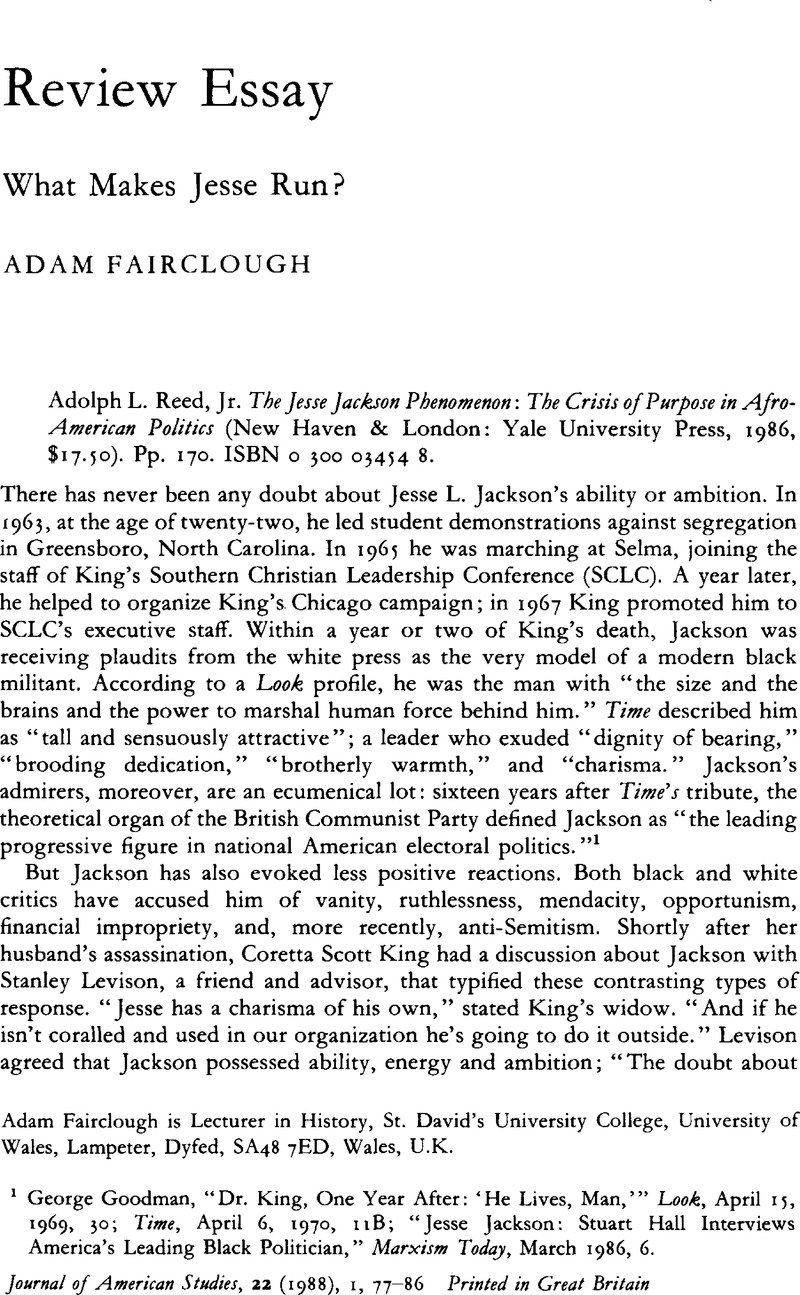No CrossRef data available.
Published online by Cambridge University Press: 16 January 2009

1 Goodman, George, “Dr. King, One Year After: ‘He Lives, Man,’” Look, April 15, 1969, 30Google Scholar; Time, April 6, 1970, 11B; “Jesse Jackson: Stuart Hall Interviews America's Leading Black Politician,” Marxism Today, March 1986, 6.Google Scholar
2 Coretta Scott King and Stanley David Levison, transcript of telephone conversation, May 15, 1968, FBI Levison file, Martin Luther King, Jr. Center for Nonviolent Social Change, Atlanta, Georgia (hereinafter cited as MLK).
3 Reynolds, Barbara A., Jesse Jackson: The Man, The Movement, The Myth (Chicago, 1975)Google Scholar; Reed, Adolph Jr., The Jesse Jackson Phenomenon: The Crisis of Purpose in Afro-American Leadership (New Haven & London, 1986).Google Scholar
4 Rustin, Bayard, “From Protest to Politics: The Future of the Civil Rights Movement,” Commentary (02 1965), 25–31.Google Scholar
5 Rustin stated this position more explicitly in his Strategies for Freedom: The Changing Patterns of Black Protest (New York, 1976), 39–42.Google Scholar
6 Reed, , The Jesse Jackson Phenomenon, 33–37.Google Scholar
7 , 2–4, 31–33, 41–60Google ScholarIbid.; Reynolds, , Jesse Jackson, 82–103Google Scholar; Myrdal, Gunnar, An American Dilemma: The Negro Problem and Modern Democracy (New York & London, 1944), 877.Google Scholar
8 The relevant economic statistics are summarized in Taylor, Barbara, Kuhn, Cliff and Miller, Marc, “After Twenty-Five Years,” Southern Exposure, Spring 1981, 120–23Google Scholar; Marable, Manning, Race, Reform and Rebellion: The Second Reconstruction in Black America, 1945–1982 (London, 1984), 173–98CrossRefGoogle Scholar; Financial Times, January 21, 1986.
9 Rustin, , “From Protest to Politics,” 29–31.Google Scholar
10 Marable, , Race, Reform and Rebellion, 167Google Scholar; Nelson, William E. Jr., “Cleveland: The Rise and Fall of the New Black Politics,” in Preston, Michael B. et al. , eds., The New Black Politics: The Search for Political Power (New York & London, 1982), 189–205Google Scholar. In Cleveland, black voter registration fell from 80% in 1967 to 47% in 1979.
11 Burnham, Walter Dean, The Current Crisis in American Politics (New York, 1982), 29–53, 123–55.Google Scholar
12 Reed, , The Jesse Jackson Phenomenon, 19–25Google Scholar. In seeking to minimize the Jackson campaign's stimulus to voter registration, Reed glosses over the fact that black registration had declined from 63% of those eligible in 1976 to 57 per cent in 1980; see Taylor, , Kuhn, and Miller, , “After Twenty-Five Years,” 124.Google Scholar
13 Reed, , The Jesse Jackson Phenomenon, 39.Google Scholar
14 , 36–38Google ScholarIbid.. In order to buttress his case, Reed employs anecdotal evidence, citing examples of “antirational” arguments that he heard from Jackson supporters. Such evidence, however, is of dubious value. First, Reed's anecdotes are examples of illogic rather than irrationality. Second, anyone who is involved in politics – in whatever party and at whatever level – will hear illogical arguments aplenty.
15 , 114–16Google ScholarIbid.. For a more positive assessment of the Jackson campaign, see Davis, Mike, Prisoners of the American Dream (London, 1986), 264–307 passim.Google Scholar
16 Reed, , The Jesse Jackson Phenomeon, 16 (quotation), 64–65, 85–87.Google Scholar
17 , 65.Google ScholarIbid.
18 13–16. Reed admits that in three of the states where it can be demonstrated that Jackson ran better among the highest income group than the lowest, there was “no more than five percentage points difference” between the two. And in five other states for which evidence was available, the data failed to support the thesis that affluent blacks were more likely to vote for Jackson.
19 Julius Jacobsen, “Union Conservatism: A Barrier to Racial Equaltiy”; Hill, Herbert, “The Racial Practices of Organized Labor,” both in Julius, Jacobsen, ed., The Negro and the American Labor Movement (New York, 1968), 1–26, 287–357Google Scholar. The United Auto Workers and the United Packinghouse Workers were the most notable exceptions: both gave important financial and political support to the civil rights movement.
20 King, Martin Luther Jr., speech to voter registration rally, Louisville, August 2, 1967, transcript, pp. 112–13Google Scholar, King Papers, MLK.
21 Reed, , The Jesse Jackson Phenomenon, 133Google Scholar; Davis, , Prisoners of the American Dream, 144–47Google Scholar; , “The Political Economy of Late Imperial America,” New Left Review, January–February, 1984, 19–21Google Scholaridem. According to Davis, union membership in the private sector workforce declined from 26 per cent in 1970 to 15 per cent in 1984.
22 Katherine Shannon, transcript of interview with Andrew J. Young, July 16, 1968, p. 8, Ralph J. Bunche Oral History Collection, Howard University, Washington, D.C.
23 Reynolds, , Jesse Jackson, 159–60Google Scholar; Jackson, Jesse L., “Black Power and White Churches,” in Littleton, A. C. and Burger, M. W., eds., Black Viewpoints (New York, 1971), 356–58.Google Scholar
24 For the frailty of black capitalism, see Marable, , Race, Reform and Rebellion, 171Google Scholar; Levitan, Sar A., Johnston, William B., and Taggart, Robert, Still A Dream: The Changing Status of Blacks Since 1960 (Cambridge, Mass., 1975), 174–77.CrossRefGoogle Scholar
25 Marxism Today, March 1986, 10–11; Stanley D. Levison and Martin Luther King, Jr., transcript of telephone conversation, February 27, 1967, FBI Levison file, MLK.
26 Ladd, Everett C. Jr., Negro Political Leadership in the South (Ithaca, 1966), 284–92.Google Scholar
27 For a critical discussion of the ethnic pluralism theory, see Franklin, Raymond J. and Resnick, Solomon, The Political Economy of Racism (New York, 1973), 136–55, 203–16Google Scholar. Empirical support for the theory of black “exceptionalism” can be found in Lieberson, Stanley L., A Piece of the Pie: Blacks and White Immigrants Since 1880 (Berkeley, 1980)Google Scholar, a quantitative analysis based upon census statistics.
28 Reed, , The Jesse Jackson Phenomenon, 33–38, 134–36.Google Scholar
29 See also Landess, Thomas H. and Quinn, Richard M., Jesse Jackson and the Politics of Race (Ottowa, Ill., 1985)Google Scholar, a jaundiced view of the 1984 campaign that dwells largely on Jackson's personal failings.
30 Burnham, , The Current Crisis in American Politics, 155, 290.Google Scholar
31 Reed, , The Jesse Jackson Phenomenon, 20–25Google Scholar; Marable, , Race, Reform, and Rebellion, 195Google Scholar; Davis, , Prisoners of the American Dream, 277–88Google Scholar; Burnham, , The Current Crisis in American Politics, 52–53.Google Scholar